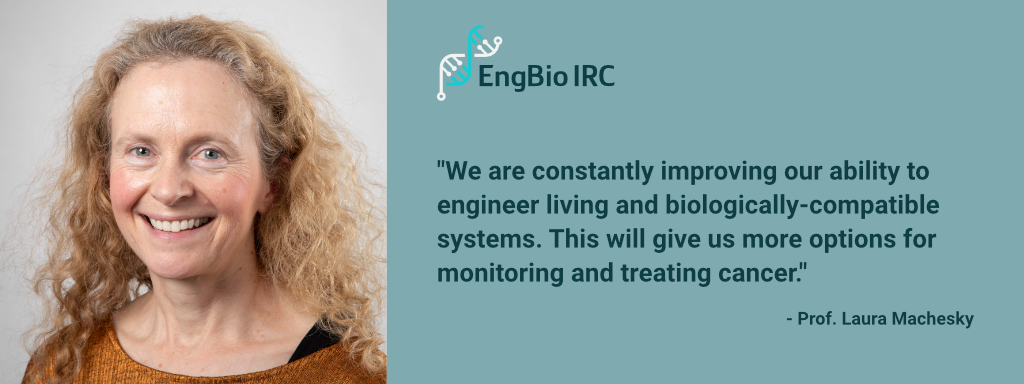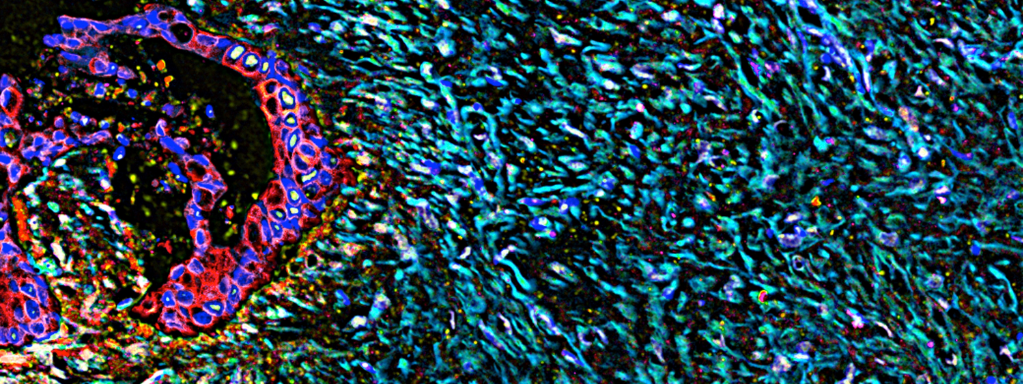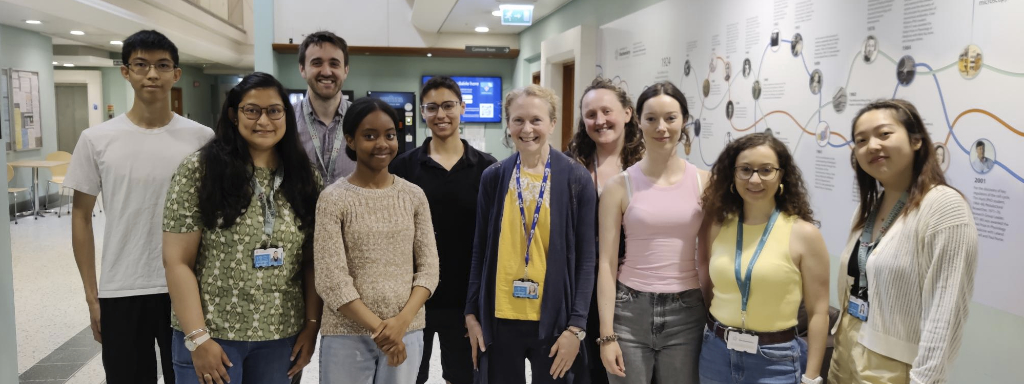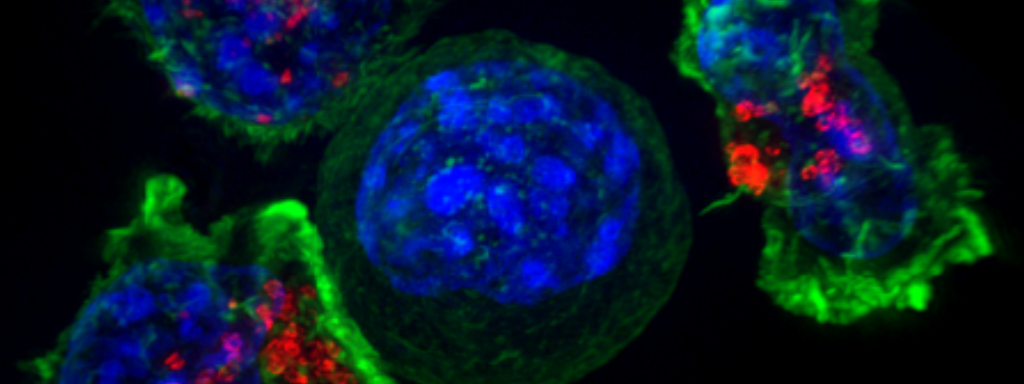
Submitted by Vicky Yee K Reid on Thu, 18/07/2024 - 12:15
Prof. Laura Machesky researches how cancer cells interact with their environment. This is an essential part of understanding and combating cancer metastasis. Find out how engineering biology and interdisciplinary work have contributed to her research.
In 2022, Professor Laura Machesky moved her lab from Glasgow to the University of Cambridge. She quickly joined the Cambridge community, becoming co-chair of the Engineering Biology IRC. In the past two years, she has played a key role in shaping Engineering Biology research at Cambridge. In an insightful conversation, Laura shares her research journey. She discusses her work on cancer metastasis and her experiences with interdisciplinary research.
Prof. Machesky, can you tell us how you became interested in cancer research?
I grew up in Michigan, USA, and studied pre-medicine at university. Whilst I was there I did an internship at the hospital genetics lab. That started my interest in fundamental cell biology. After that I went to The John Hopkins University School of Medicine and studied for my PhD. Following this, I gained a postdoctoral fellowship to train at the MRC-LMB in Cambridge and the MRC-LMCB in London. In 1998, I set up my lab at the University of Birmingham, where I worked for 9 years, before moving to the Beatson Institute for Cancer Research in Glasgow in 2007. My research focuses on basic biology and biochemistry, but it has always had a link to human disease. I became interested in cancer when I moved to the Beatson Institute. I realised that the research I was working on - understanding how cells move and migrate - was essential for cancer metastasis.
Can you tell us more about your current research?
I am currently interested in understanding how the tumour microenvironment affects metastasis. We are particularly interested in pancreatic cancer, which is one of the most metastatic cancers. We are studying how the stiff environment of a tumour can contribute to cancer cells moving and escaping. To do this we create realistic models of the tumour microenvironment. We can use these models to understand how cancer cells respond to changes in their environment.
We are studying how the stiff environment of a tumour can contribute to cancer cells moving and escaping. To do this we create realistic models of the tumour microenvironment.”
Pancreatic tumour cells in their microenvironment.
How do you feel your work is related to Engineering Biology?
We work with physicists and engineers to help us understand the mechanics of the tumour microenvironment. For example, how do cells sense and respond to mechanical pressure. We also use engineering to create physiologically correct models of the cancer microenvironment.
Molecular and synthetic biology tools are also key for our research. We constantly use genetic tools, like fluorescent probes and optogenetics. These allow us to make precise changes to cells and then study how they respond, giving us insight into how cancer cells work.
When I came to Cambridge I was keen to join the Engineering Biology IRC. Cambridge is a fantastic place to interact with experts in such a wide variety of fields. I was excited by the opportunity to meet people across the university, especially people working in other disciplines. It's been a great experience to network and meet new collaborators. I also wanted to be able to contribute to the community and help support early career researchers.
How has interdisciplinary and collaborative working shaped your research?
I have always worked in quite an interdisciplinary way. Over the years I've worked with medics, physicists and engineers. I believe it helps you to think in different ways and answer questions you wouldn't be able to otherwise. I also find interdisciplinary working fun! It makes you look at different ways of addressing a problem.
Over the years I've worked with medics, physicists and engineers. I believe it helps you to think in different ways and answer questions you wouldn't be able to otherwise.”
The Machesky Lab is home to staff and students from a variety of disciplines.
What challenges have you encountered in interdisciplinary research?
Communication is definitely the biggest challenge. Bridging the gap between different disciplines' jargon and methodologies. It takes time and effort to make sure that everyone is on the same page. Sometimes it is also difficult when applying for grants. You have to be able to justify how your work is interesting and innovative in multiple fields.
I have hope that some of the challenges can be overcome as science education changes. If undergraduate and postgraduate courses become more multidisciplinary, we will produce scientists who find it easier to think and work across disciplines.
What are your thoughts on the future of cancer research?
We are constantly improving our ability to engineer living and biologically-compatible systems. This will give us more options for monitoring and treating cancer. Right now the most prominent synthetic biology application for cancer is CAR-T therapy. This is where immune cells (T cells) are removed from a patient's body, edited slightly and then put back into the patient. The change in the T cells causes them to recognise and attack cancer cells, helping to treat the cancer. This therapy is already being used in some cases. Generally, personalised and precision medicine approaches, like CAR-T therapy, show a lot of promise. There are also great leaps to be made in drug-delivery systems.
These advances also come with challenges though. Introducing biological materials into humans has a lot of medical and ethical implications. For me, this has been another exciting aspect of joining the IRC. It has pushed me to think not just "wow, this is an amazing, cool new technique", but also "what are the potential societal impacts?".
We are constantly improving our ability to engineer living and biologically-compatible systems. This will give us more options for monitoring and treating cancer."
Killer T-cells attacking a cancer cell
More Information
For more information about Laura’s work see her website. You can also follow her on X (Twitter).
Learn more about how researchers at the University of Cambridge are changing the story of cancer.
Author Information
Credits and Acknowledgements
Image Credits
- Prof. Laura Machesky. Department of Biochemistry, University of Cambridge.
- Pancreatic tumour cells in their microenvironment. NIH Image Library: Neelima Shah and Edna Cukierman, Fox Chase Cancer Center, National Cancer Institute, National Institutes of Health.
- The Machesky Lab. Department of Biochemistry, University of Cambridge.
- Killer T-cell attacking a cancer cell. NIH Image Library: Alex Ritter, Jennifer Lippincott Schwartz and Gillian Griffiths, National Institutes of Health.




